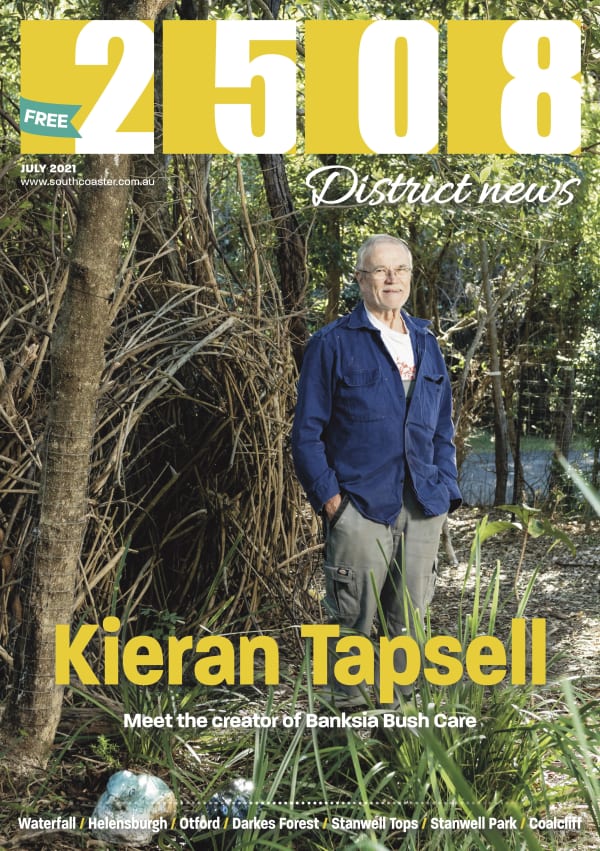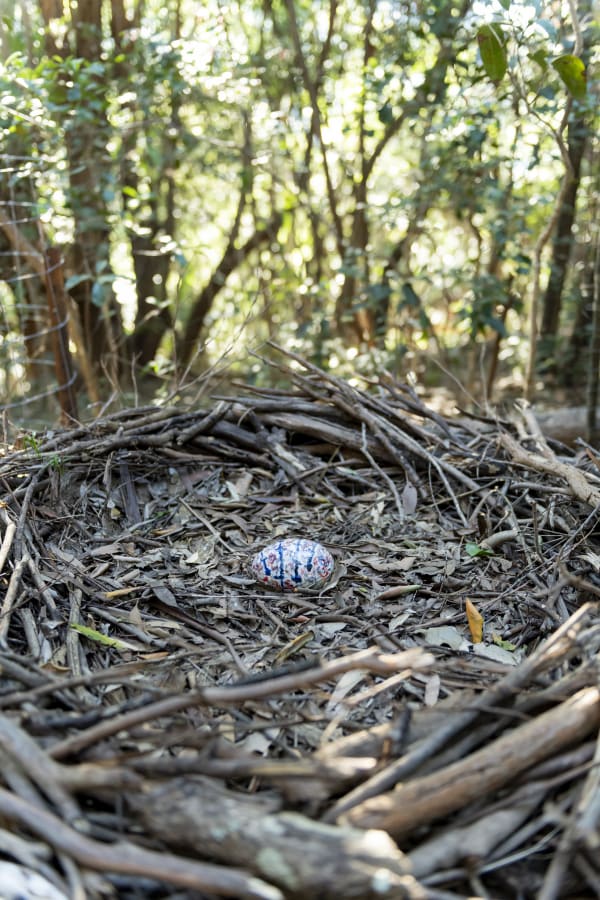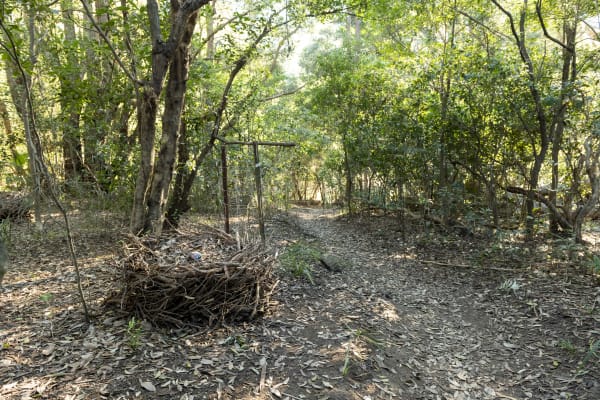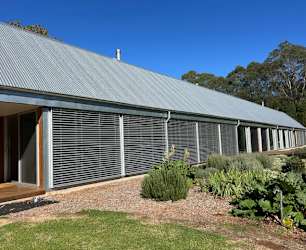Kieran Tapsell is one of the artists opening their studios this weekend, 19 and 20 November 2022, for the inaugural Northern Illawarra Art Trail
If you go down to the endangered littoral rainforest today, you’re in for a big surprise.
Lining the bush track from Stanwell Park kiosk up to Stanwell Avenue are giant bird’s nests woven with stalks of lantana, senna and ochna. All terrible invasive weeds choking our rainforest, now reinvented as bush sculpture.
Inside the nests are porcelain eggs featuring the works of great painters – think Van Gogh’s sunflowers and Picasso’s bulls.
The open-air art show is curated by Banksia Bush Care founder Kieran Tapsell, who fires the eggs in a kiln in the backyard of his home on Stanwell Avenue and then shares them with the community to decorate.
Recent additions include eggs the size of an emu’s painted by Stanwell Park Preschool children (Kieran reckons their work bears a striking resemblance to the work of Archibald winner John Olsen). They are part of the Modern Art Tributes on Eggs (MATE) Exhibition.
Kieran leads us on a tour of the bush gallery, for which sensible walking shoes are recommended.
“There’s a Picasso – that’s one I did,” he says, lifting an egg from a nest.
“Here’s Guernica…”
“You can’t take art too seriously.
“Though it does take a certain skill to reproduce a painting of that size on an egg,” he adds, laughing.
It’s a delightful stroll and educational too, with signs made by Otford’s Natasha Watson identifying the rainforest trees, from lilly pillies to Illawarra flame trees (Kieran’s favourite).
The show continues all the way up the track to Stanwell Reserve, where two porcelain bowerbirds – Kieran’s own work – sit beneath a colossal bower of branches more than six feet tall.
Male satin bowerbirds are famous home decorators; they love to collect blue objects to entice ladies to their bowers. Sometimes Kieran scatters blue items around the giant bower but they don’t last long. The real bird nicks them.
“There was one bowerbird, I used to call him Rupert because he was really greedy.”
The Bower is at the heart of Banksia Bush Care operations. It’s where we meet two local volunteers, Lydia Smith and Torin O’Connell.
“I thought it was a fantastic initiative,” says Lydia, who lives just down the street.
“I’d see Kieran post on Facebook, we’re doing regeneration of the bush and making these nests…
“So we got a whole bunch of eggs and painted them for my daughter’s fifth birthday party. That was really fun. That was when we started getting involved, painting the eggs and making something really wonderful out of clearing the bush. Making it a nice space for everyone to enjoy.”

There are currently about 14 Banksia Bush Care volunteers, all locals. The community stepped in when Kieran’s usual supply of willing backpacker workers dried up due to the pandemic.
Kieran is a retired lawyer who moved to Stanwell Park in 1972. He has been weeding, planting and defending young trees from Rusa deer for 50 years.
“Basically, I started doing it myself,” he says. “Then I got the backpackers in.”
Kieran registered with two cultural exchange schemes, HelpX and Work Away, offering bunk-bed accommodation at his home in exchange for bush care work. “Most of this was done with backpackers. They were terrific.”
Today, tonnes of weeds have been cleared and about 1400 native trees planted. Banksia Bush Care has become a local treasure – not only is it a rainforest haven, it’s a community art project loved by residents of all ages.
Earlier this year, Kieran published the story behind the nature garden in A Guide to the Banksia Bush Care Site on the Stanwell Avenue Reserve. Below is an edited extract from this free guide, highly recommended for anyone interested in Stanwell Park’s human and ecological history.
Readers can read the full PDF here.
Extract from ‘A Guide to the Banksia Bush Care Site on the Stanwell Avenue Reserve’, by Kieran Tapsell (2021)
By 2017, some friends and I had removed a huge amount of weed material and put it in a pile further along in the circle where we expected the Council could collect it. Two Council officers came up and were pleased with what had been done and suggested that we should become volunteers within the Council’s bush care program. They also told us that it the Council’s preferred policy to leave the weed material on site.
This created a problem for the owners of No. 19, 31 and 35 Stanwell Avenue, and the Child Care Centre because the amount of weed material was huge and having big heaps of dried sticks and fines in heaps presented a fire hazard.
Gaby Porter, a sculptor from Wombarra, had made a giant bower and a nest in her garden, and this provided some inspiration for creativity in the disposal of the weeds. The nests we created were filled with leaf litter and became compost heaps for the trees we planted downhill of them. The leaf litter composted with the rain and sent the nutrient to the tree around which we had built a small dam to contain it.
I made some porcelain eggs, more as a joke, to put in the nests. Like most places, Stanwell Park has a history of vandalism and to try and discourage that, I painted the bottom of the eggs with underglaze with the message: “Art in the Park. Please Do Not Steal Me,” and signed it “Banksia,” because the nests were three-dimensional graffiti in a public park, and at that stage, no one really knew who was making them.
The Council bush care people were supportive of what we were doing and agreed to call the Dress Circle the “Banksia Bush Care” site.
From bush art to compost bins
The composting nests have been successful as can be seen from the south-western side of the bush care area where some planted trees of the same species (Illawarra flame trees and red cedars) have a nest, and some do not.
Those with nests have grown as much as 1.5 metres higher than those without. There are now 186 giant nests on the site, fertilising the trees planted downhill of them.
The nests surprisingly act as a fire retardant. The outside burns, but the wet composting centre has the effect of restricting the airflow.
I tested my hunch with an experiment at another place. I built some nests on the property and filled them with leaf litter. I also made a heap of an equivalent quantity of sticks a few metres away and left them in the weather – which is effectively what the Council wanted us to do with the weed material. After two years out in the weather, both were burned side by side. The difference was significant, with the nest taking twice as long to burn and with half the intensity. The composted centre did not burn except for the top 5cms.
The real test came on 4th January 2020 when a huge fire storm raced through the property [near Burrill Lake] and burned the house and all the forest, including the rainforest that had survived a fire in 1968. The temperature inside the house had to be 1,250 degrees because the glaze on my ceramics inside the house melted and then cooled.
The centres of two of the nests survived the firestorm. While the nests’ exteriors will burn, they will do so slowly, and as the compost material breaks down and contracts, the nest can be used continually to fill up with excessive leaf and fallen stick material, which can significantly increase bushfire intensity if left spread on the ground.
The Banksia Bush Care volunteers
Banksia Bush Care has 12 local volunteers who work with me as the coordinator. The arrangements are informal to suit the free time of the individuals. Pre-Covid, we signed up 20 backpackers as volunteers who were given free board and accommodation in return for a few hours work per day. Volunteers have provided 2,900 manhours work within the Dress Circle.
The origins of Art in the Park
Art in the Park started as a creative way of dealing with huge quantities of weed material. The giant bower was created for that reason, but it also provided an opportunity to educate people about the extraordinary bowerbird.
The nests were created for the same reason, but they also had a more practical object of providing compost heaps and disposing of combustible material in ways that reduced the bushfire hazard. There has been little vandalism of the eggs, despite the obvious temptations, and we have of spare ones when it does happen.
The eggs also became a way of involving the community in the project. Some 45 eggs in the nests have now been painted by residents, most of them by children, creating a kind of bush art gallery. Another 20 are being painted.
The Child Care Centre has also had their children paint smaller wooden eggs and these have also been placed in the nests during the children’s trips with their carers through the bush.
Oh, deer!
Rusa deer from Indonesia were introduced into the Royal National Park in 1906. When I moved into the area in 1972, they were occasionally seen around the Otford area. They were rarely seen in Stanwell Park, and certainly not in the Dress Circle until about 20 years ago. Then a buck with a couple of does appeared. He did a bit of damage, but not all that much to be worried about. Then they disappeared for a couple of years, and the regeneration flourished with ferns and grasses around the trees that I planted.
About five years ago, a herd of as many as 10 Rusa bucks started living in the Dress Circle. They ring-barked the young native trees and left gaping wounds in older ones. Residents reported seeing between 20 and 30 deer in the picnic areas of Stanwell Park during some dry periods. It was pointless planting any trees in bushland without providing them with protection.
In 2019, we approached Wollongong Council about putting up a deer fence within the littoral rainforest because not only were rainforest trees being ringbarked, but they were eating practically every new native tree that was coming up.
With the assistance of Wollongong Council, we erected a 3,000-square-metre deer fence in the sensitive area behind the sand dune.
The Future
There is still weed material that needs to be removed from between 31 and 35 Stanwell Avenue. There is also Lantana and Asparagus Fern on the southern side of the Child Care Centre. Even when these areas have been regenerated, there will need to be continuous maintenance until the weed seed bank is exhausted.
Want to volunteer? Kieran posts updates on the Stanwell Park Community Forum Facebook page, and can be contacted via kierant@ozemail.com.au or 0410 322 602
Thanks to Anthony Warry for the photography in this feature.
















